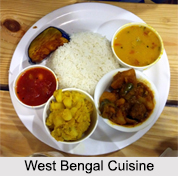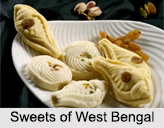 West Bengal Cuisine has been influenced by the Muslim rulers, the British rulers and the inhabitation of Jews, Afghans and Chinese. The Dutch and the French had established colonies in West Bengal as well and had a great impact on Bengal’s culinary habits.
West Bengal Cuisine has been influenced by the Muslim rulers, the British rulers and the inhabitation of Jews, Afghans and Chinese. The Dutch and the French had established colonies in West Bengal as well and had a great impact on Bengal’s culinary habits.Features of West Bengal Cuisine
Although the food habits, tastes, preferences and choice of items vary with different districts, communities and religions, the basic course generally remains the same with rice and fish playing a dominant role. Rice is the staple diet since it is grown widely. It is eaten in various forms as well - puffed, beaten, boiled and fried depending on the meal. Lightly fermented rice is also used as breakfast in rural communities known as ‘Panta Bhat’. Mustard Oil is the primary cooking medium in Bengali cuisine. Milk is an important source of nutrition, and also a key ingredient in Bengal’s desserts. Most sweets are made from Chenna. Sweets occupy an important place in the diet of Bengalis and at their social ceremonies.
Use of Spice in West Bengal Cuisine
 West Bengal cuisine involves the use of huge variety of spices like bay leaf, dry red chilli, turmeric, coriander, nutmeg, mace, saffron, poppy seeds and many more. ‘Pachphoron’ which is a mixture of 5 seed type spices namely; fenugreek, fennel, kala jeera, mustard, cumin, ‘Garam Masala’ which is a mixture of cardamom, cinnamon and clove. Phoron that is frying the spices singly or in combinations either at the beginning of preparing a recipe or adding later to it plays a dominant role in Bengali cooking style.
West Bengal cuisine involves the use of huge variety of spices like bay leaf, dry red chilli, turmeric, coriander, nutmeg, mace, saffron, poppy seeds and many more. ‘Pachphoron’ which is a mixture of 5 seed type spices namely; fenugreek, fennel, kala jeera, mustard, cumin, ‘Garam Masala’ which is a mixture of cardamom, cinnamon and clove. Phoron that is frying the spices singly or in combinations either at the beginning of preparing a recipe or adding later to it plays a dominant role in Bengali cooking style.For more, visit the link below: